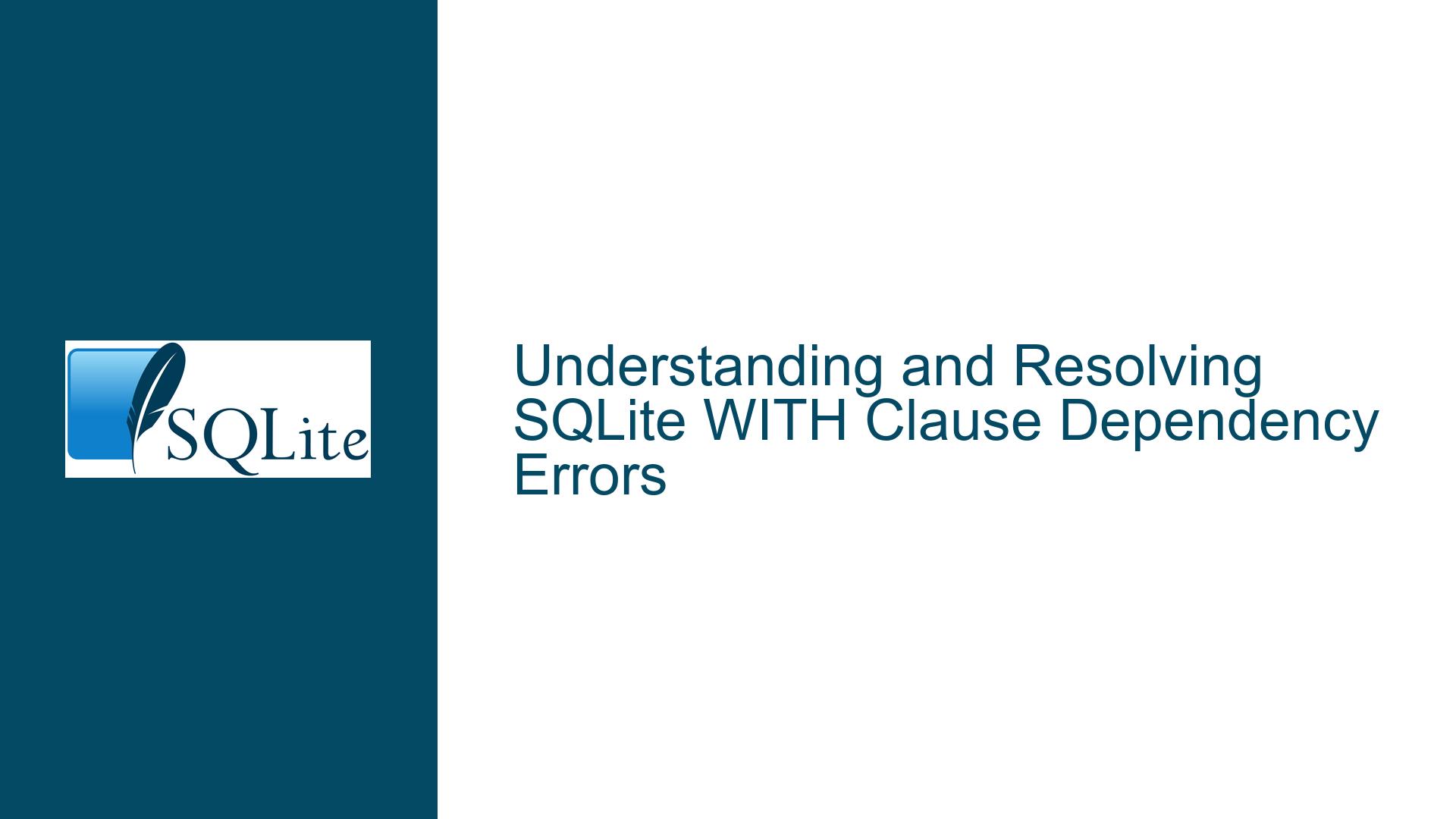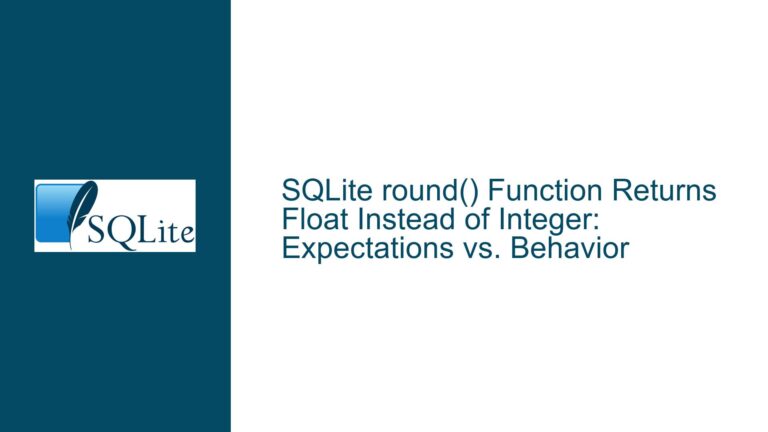and Resolving SQLite WITH Clause Dependency Errors
Issue Overview: Dependency Errors in Nested WITH Clause Definitions
In SQLite, the WITH clause, also known as Common Table Expressions (CTEs), is a powerful tool for creating temporary result sets that can be referenced within a larger query. CTEs are particularly useful for breaking down complex queries into simpler, more manageable parts. However, when attempting to reference one CTE within another, users often encounter dependency errors, such as the "Error: in prepare, near ‘a’: syntax error (1)" mentioned in the discussion. This error arises when a CTE is referenced in another CTE definition without adhering to SQLite’s syntax and dependency rules.
The core issue revolves around the incorrect usage of CTE dependencies. In the provided example, the user attempts to define a CTE b that depends on the columns of CTE a. However, the initial approach fails because SQLite does not allow direct column references from one CTE to another within the same WITH clause without using a SELECT statement. This limitation is not immediately obvious, especially to those transitioning from other SQL databases where such references might be allowed.
The error message "Error: in prepare, near ‘a’: syntax error (1)" is SQLite’s way of indicating that the syntax used to reference CTE a within the definition of CTE b is invalid. This error is a common stumbling block for developers who are accustomed to more permissive SQL dialects or who are new to SQLite’s specific requirements for CTE usage.
Possible Causes: Misunderstanding SQLite’s CTE Dependency Handling
The primary cause of the error is a misunderstanding of how SQLite handles dependencies between CTEs. In SQLite, each CTE within a WITH clause is treated as an independent entity. This means that while you can reference a CTE in the main query or in subsequent CTEs, you cannot directly reference the columns of one CTE within the definition of another CTE without using a SELECT statement.
In the example provided, the user attempts to define CTE b by directly referencing the columns of CTE a (a.a1, a.a2, etc.) within the VALUES clause. This approach is invalid because SQLite does not support direct column references between CTEs in this manner. Instead, SQLite requires that any reference to another CTE within a CTE definition must be done through a SELECT statement.
Another potential cause of confusion is the assumption that SQLite’s CTE behavior is identical to that of other SQL databases. While many SQL databases allow for more flexible referencing between CTEs, SQLite enforces stricter rules to ensure clarity and prevent ambiguous references. This difference can lead to errors when developers apply practices from other databases to SQLite without fully understanding its specific requirements.
Additionally, the error may be exacerbated by a lack of familiarity with SQLite’s error messages. The message "Error: in prepare, near ‘a’: syntax error (1)" is somewhat cryptic and does not explicitly state that the issue is related to CTE dependencies. This can make it difficult for developers to diagnose the problem without a deeper understanding of SQLite’s syntax rules.
Troubleshooting Steps, Solutions & Fixes: Correcting CTE Dependency References
To resolve the issue, it is essential to understand how to correctly reference one CTE within another in SQLite. The solution involves using a SELECT statement to reference the columns of the dependent CTE. This approach ensures that SQLite can properly parse and execute the query without encountering syntax errors.
In the example provided, the user attempts to define CTE b using the columns of CTE a directly within the VALUES clause. The correct approach is to use a SELECT statement to reference the columns of CTE a within the definition of CTE b. Here is the corrected query:
WITH
a (a1, a2, a3, a4) AS (VALUES (1,2,3,4)),
b (b1, b2, b3, b4) AS (SELECT a.a1*10, a.a2*10, a.a3*10, a.a4*10 FROM a),
c (c1, c2, c3, c4) AS (VALUES (111,222,333,444))
SELECT * FROM a
UNION ALL
SELECT * FROM b
UNION ALL
SELECT * FROM c;
In this corrected query, CTE b is defined using a SELECT statement that references the columns of CTE a. This approach adheres to SQLite’s syntax rules and allows the query to execute without errors.
It is also important to note that the order of CTE definitions within the WITH clause can impact the query’s execution. In SQLite, CTEs are evaluated in the order they are defined. Therefore, if CTE b depends on CTE a, CTE a must be defined before CTE b. This ordering ensures that SQLite can correctly resolve the dependencies between the CTEs.
Another consideration is the use of aliases within the SELECT statement. When referencing columns from another CTE, it is often helpful to use aliases to make the query more readable and to avoid potential conflicts with column names in other parts of the query. For example, the following query uses aliases to clarify the relationship between the columns of CTE a and CTE b:
WITH
a (a1, a2, a3, a4) AS (VALUES (1,2,3,4)),
b (b1, b2, b3, b4) AS (SELECT a1*10 AS b1, a2*10 AS b2, a3*10 AS b3, a4*10 AS b4 FROM a),
c (c1, c2, c3, c4) AS (VALUES (111,222,333,444))
SELECT * FROM a
UNION ALL
SELECT * FROM b
UNION ALL
SELECT * FROM c;
In this query, the SELECT statement within CTE b uses aliases (b1, b2, b3, b4) to clearly indicate the relationship between the columns of CTE a and CTE b. This approach can make the query easier to understand and maintain, especially when dealing with more complex queries involving multiple CTEs.
In addition to correcting the syntax, it is also important to consider the performance implications of using CTEs in SQLite. While CTEs can simplify complex queries, they can also introduce overhead, particularly when dealing with large datasets or deeply nested CTEs. To optimize performance, it is often helpful to limit the number of CTEs used in a query and to ensure that each CTE is as efficient as possible.
For example, if CTE a is a simple VALUES clause, as in the example provided, the performance impact is likely minimal. However, if CTE a were a more complex query involving joins, aggregations, or subqueries, the performance impact could be more significant. In such cases, it may be beneficial to evaluate whether the use of CTEs is necessary or whether the query can be rewritten to achieve the same result without using CTEs.
Finally, it is worth noting that SQLite’s CTE implementation is continually evolving, and future versions of SQLite may introduce new features or optimizations that impact how CTEs are used. As such, it is important to stay informed about changes to SQLite’s syntax and behavior, particularly when working with complex queries involving CTEs.
In conclusion, the key to resolving dependency errors in SQLite’s WITH clause is to understand and adhere to SQLite’s syntax rules for referencing one CTE within another. By using SELECT statements to reference dependent CTEs and ensuring that CTEs are defined in the correct order, developers can avoid common pitfalls and create efficient, error-free queries. Additionally, by considering the performance implications of using CTEs and staying informed about changes to SQLite’s implementation, developers can ensure that their queries are both effective and efficient.






